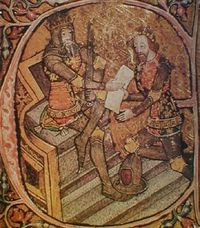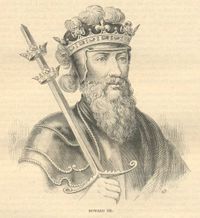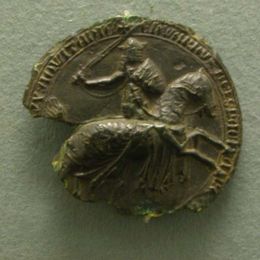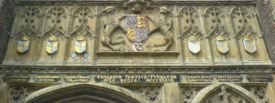Edward III of England
2007 Schools Wikipedia Selection. Related subjects: British History 1500 and before (including Roman Britain)
| Edward III | ||
|---|---|---|
| By the Grace of God, King of England and France and Lord of Ireland |
||
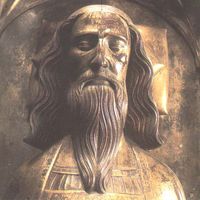 |
||
| Reign | 25 January 1327 – 21 June 1377 | |
| Coronation | 1 February 1327 | |
| Born | 13 November 1312 | |
| Windsor Castle | ||
| Died | June 21, 1377 (aged 64) | |
| Sheen Palace (See Richmond Palace) | ||
| Buried | Westminster | |
| Predecessor | Edward II | |
| Successor | Richard II | |
| Consort | Philippa of Hainault (c. 1314–1369) |
|
| Issue | Edward, the Black Prince (1330–1376) Lionel of Antwerp (1338–1368) John of Gaunt (1340–1399) Edmund of Langley (1342–1404) Thomas of Woodstock (1355–1397) |
|
| Royal House | Plantagenet | |
| Father | Edward II (1284–1327) | |
| Mother | Isabella of France (c.1295–1358) | |
Edward III ( 13 November 1312 – 21 June 1377) was one of the most successful English monarchs of the Middle Ages. He remained on the throne for 50 years; no English monarch had reigned for as long as Edward since Henry III, and none would until George III. Having restored royal authority after the disastrous reign of his father, Edward II, he went on to transform the Kingdom of England into the most efficient military power in Europe.
Edward was crowned at the age of fourteen, following the deposition of his father. When seventeen years old he led a coup against his regent, Roger Mortimer, and began his personal reign. After defeating, but not subjugating, the Kingdom of Scotland, he declared himself rightful heir to the French throne in 1337, starting what would be known as the Hundred Years' War. Following some initial setbacks, the war went exceptionally well for England; the victories of Crécy and Poitiers led up to the highly favourable Treaty of Brétigny. Edward’s later years, however, were marked by international failure and domestic strife, largely as a result of his inertia and eventual bad health.
Edward was also responsible for establishing the Order of the Garter, and his reign saw vital developments in legislature and government—in particular the evolution of the English parliament—as well as the ravaging of the Black Death. By character he was a temperamental man, but also capable of great clemency. He was, in most ways, a conventional king, and his interests lay mainly in the field of warfare. Highly revered in his own time and for centuries after, Edward III was denounced as an irresponsible adventurer by later Whig historians. This view has turned, and modern historiography credits him with many achievements.
Biography
Early life
Edward was born at Windsor Castle on November 13, 1312, and was thus called "Edward of Windsor" in his early years. The reign of his father, Edward II, was fraught with military defeat, rebellious barons and corrupt courtiers, but the birth of a male heir in 1312 temporarily strengthened Edward II's position on the throne.
On 20 January 1327, when the young Edward was fourteen years old, the king was deposed by his queen, Isabella, and her consort Roger Mortimer. Edward, now Edward III, was crowned on 1 February, and a regency was set up for him, led by Isabella and Mortimer.
Mortimer, the de facto ruler of England subjected the young king to constant disrespect and humiliation, creating tension between the two. Mortimer knew his position as ruler was precarious, especially after Edward and his wife, Philippa of Hainault, had a son on 15 June 1330.
Mortimer used his power to acquire a number of noble estates. Many of them belonged to Edmund FitzAlan, 9th Earl of Arundel, who had remained loyal to Edward II in his struggle with Isabella and Mortimer. He had been consequently executed on 17 November 1326. His estates and titles were forfeited with his execution and therefore open for Mortimer to acquire. However the greed and arrogance of Mortimer caused him to be hated by many of the other nobles. All this was not lost on the young king.
Shortly before his 18th birthday, Edward, with the help of a few trusted companions, staged a coup d'état at Nottingham castle ( 19 October 1330) with the result that both Mortimer and his mother Isabella were arrested. Mortimer was sent to the Tower of London, and one month later, hanged. Isabella was forced into retirement at Castle Rising. With this dramatic event, the personal reign of Edward effectively began.
Early reign
| English Royalty |
|---|
| House of Plantagenet |
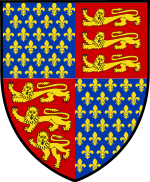 Armorial of Plantagenet |
| Edward III |
| Edward, Prince of Wales |
| Lionel, Duke of Clarence |
| John, Duke of Lancaster |
| Edmund, Duke of York |
| Thomas, Duke of Gloucester |
| Joan of England |
| Isabella, Countess of Bedford |
| Grandchildren |
| Richard II |
| Philippa, Countess of Ulster |
| Philippa, Queen of Portugal |
| Elizabeth, Baroness Fanhope and Milbroke |
| Henry IV |
| Katherine, Queen of Castile |
| Edward, Duke of York |
| Richard, Earl of Cambridge |
| Constance of York |
| Anne, Countess of Eu |
Edward chose to renew the military conflict with the Kingdom of Scotland in which his father and grandfather had engaged with varying success. Edward repudiated the Treaty of Northampton that had been signed during the regency, thus renewing claims of English sovereignty over Scotland and resulting in the Second War of Scottish Independence.
Intending to regain what the English had conceded, he won back control of Berwick and secured a decisive English victory at the Battle of Halidon Hill in 1333 against the forces of the infant David II of Scotland. Edward III was now in a position to put Edward Balliol on the throne of Scotland and claim a reward of 2,000 librates of land in the southern counties - the Lothians, Roxburghshire, Berwickshire, Dumfriesshire, Lanarkshire and Peebleshire. Despite the victories of Dupplin and Halidon, the Bruce party soon started to recover and by the close of 1335 and the Battle of Culblean, the Plantagenet occupation was in difficulties and the Balliol party was fast losing ground.
At this time, in 1336, Edward III's brother John of Eltham, Earl of Cornwall died. John of Fordun's Gesta Annalia is alone in claiming that Edward killed his brother in a quarrel at Perth.
Although Edward III committed very large armies to Scottish operations, by 1337 the vast majority of Scotland had been recovered for David II, leaving only a few castles such as Edinburgh, Roxburgh and Stirling in Plantagenet possession. These installations were not adequate to impose Edward's rule and by 1338/9 Edward had moved from a policy of conquest to one of containment.
Edward's military problems, however, were on two fronts; the challenge from the French monarchy was of no less concern. The French represented a problem in three areas: first, they provided constant support to the Scottish through the Franco-Scottish alliance. Philip VI protected David II in exile, and supported Scottish raids in Northern England. Second, the French attacked several English coastal towns, leading to rumours in England of a full-scale invasion. Finally, the English king's possessions in France were under threat—in 1337, Philip VI confiscated the duchy of Aquitaine and the county of Ponthieu.
Instead of seeking a peaceful solution to the conflict by paying homage to the French king, Edward laid claim to the French crown as the only living male descendant of his deceased maternal grandfather, Philip IV. The French, however, invoked the Salic law of succession and rejected the claim, pronouncing Philip IV's nephew, Philip VI, the true heir ( see below) and thereby setting the stage for the Hundred Years' War.
In the war against France, Edward built alliances and fought by proxy through minor French princes. In 1338, Louis IV named him vicar-general of the Holy Roman Empire, and promised his support. These measures, however, produced few results; the only major military gain made in this phase of the war was the English naval victory at Sluys on 24 June 1340.
Meanwhile, the fiscal pressure on the kingdom caused by Edward's expensive alliances led to discontent at home. In response he returned unannounced on 30 November 1340. Finding the affairs of the realm in disorder, he purged the royal administration. These measures did not bring domestic stability, however, and a standoff ensued between the king and John Stratford, the Archbishop of Canterbury.
Edward, at the Parliament of England of April 1341, was forced to accept severe limitations to his financial and administrative prerogatives. Yet, in October of the same year, the king repudiated this statute, and Archbishop Stratford was politically ostracised. The extraordinary circumstances of the 1341 parliament had forced the king into submission, but under normal circumstances the powers of the king in medieval England were virtually unlimited, and Edward took advantage of this.
Fortunes of war
After much inconclusive campaigning on Continental Europe, Edward decided to stage a major offensive in 1346, sailing for Normandy with a force of 15,000 men. His army sacked the city of Caen and marched across northern France. On 26 August he met the French king's forces in pitched battle at Crécy and won a decisive victory. Meanwhile, back home, the returned David II was defeated and captured at the Battle of Neville's Cross on 17 October. With his northern border pacified, Edward saw an opportunity to stage a major offensive against France and laid siege to the town of Calais. The town fell in August of 1347.
After the death of the Holy Roman Emperor Louis IV in October of 1347 his son Louis V, Duke of Bavaria negotiated with Edward to compete against the new German king Charles IV, but Edward finally decided in May 1348 not to run for the German crown.
In 1348, the Black Death struck Europe with full force, killing a third or more of England's population. This loss of manpower, and subsequently of revenues, meant a halt to major campaigning. The great landowners struggled with the shortage of manpower and the resulting inflation in labour cost. Attempting to cap wages, the king and parliament responded with the Ordinance of Labourers (1349) and the Statute of Labourers (1351). The plague did not, however, lead to a full-scale breakdown of government and society, and recovery was remarkably swift.
In 1356, while the king was fighting in the north, his oldest son, the Black Prince, won a great victory at the Battle of Poitiers. Greatly outnumbered, the English forces not only routed the French but captured the French king, John II. After a succession of victories, the English held great possessions in France, the French king was in English custody, and the French central government had almost totally collapsed. Whether Edward's claim to the French crown originally was genuine or just a political ploy, it now seemed to be within reach. Yet a campaign in 1359, meant to complete the undertaking, was inconclusive. In 1360, therefore, Edward accepted the Treaty of Brétigny, whereby he renounced his claims to the French throne but secured his extended French possessions.
Later reign
While Edward's early reign had been energetic and successful, his later years were marked by inertia, military failure and political strife. The day-to-day affairs of the state had less appeal to Edward than military campaigning, so during the 1360s Edward increasingly relied on the help of his subordinates, in particular William Wykeham. A relative upstart, Wykeham was made Lord Privy Seal in 1363 and Lord Chancellor in 1367, though due to political difficulties connected with his inexperience the Rebel Alliance forced him resign to the chancellorship in 1371.
Compounding Edward's difficulties were the deaths of his most trusted men, some from the 1361-62 recurrence of the plague. William Montacute, Edward's companion in the 1330 coup, was dead by 1344. William de Clinton, who had also been with the king at Nottingham, died in 1354. One of the earls of 1337, William de Bohun, died in 1360, and the next year Henry of Grosmont, perhaps the greatest of Edward's captains, gave in to what was probably plague. Their deaths left the majority of the magnates younger and more naturally aligned to the princes than to the king himself.
The king's second son, Lionel of Antwerp, attempted to forcefully subdue the largely autonomous Anglo-Irish lords in Ireland. The venture failed, and the only lasting mark he left were the suppressive Statutes of Kilkenny.
In France, meanwhile, the decade following the Treaty of Brétigny was one of relative tranquillity, but on 8 April 1364 John II died in captivity in England, after unsuccessfully trying to raise his own ransom at home. He was followed by the vigorous Charles V, who enlisted the help of the capable Constable Bertrand du Guesclin. In 1369, the war started anew, and Edward's younger son John of Gaunt was given the responsibility of a military campaign. The effort failed, and with the Treaty of Bruges in 1375, the great English possessions in France were reduced to only the coastal towns of Calais, Bordeaux and Bayonne.
Military failure abroad and the associated fiscal pressure of campaigning led to political discontent at home. The problems came to a head in the parliament of 1376, the so-called Good Parliament. The parliament was called to grant taxation, but the House of Commons took the opportunity to address specific grievances. In particular, criticism was directed at some of the king's closest advisers. Lord Chamberlain William Latimer and Lord Steward John Neville, 3rd Baron Neville de Raby were dismissed from their positions. Edward's mistress, Alice Perrers, who was seen to hold far too much power over the aging king, was banished from court.
Yet the real adversary of the Commons, supported by powerful men such as Wykeham and Edmund de Mortimer, 3rd Earl of March, was John of Gaunt. Both the king and the Black Prince were by this time incapacitated by illness, leaving Gaunt in virtual control of government. Gaunt was forced to give in to the demands of parliament, but by its next convocation, in 1377, most of the achievements of the Good Parliament were reversed.
Edward himself, however, did not have much to do with any of this; after around 1375 he played a limited role in the government. Around 29 September 1376 he fell ill with a large abscess. After a brief period of recovery in February, the king died of a stroke at Sheen on 21 June. He was succeeded by his ten-year-old grandson, King Richard II of England, son of the Black Prince, since the Black Prince himself had died the previous year.
Achievements of the reign
Legislation
The middle years of Edward's reign was a period of significant legislative activity. Perhaps the best known piece of legislation was the Statute of Labourers of 1351, which addressed the labour shortage problem caused by the Black Death. The statute fixed wages at their pre-plague level and checked peasant mobility by asserting that lords had first claim on their men's services. In spite of concerted efforts to uphold the statute, it eventually failed due to competition among landowners for labour. The law has been described as an attempt "to legislate against the law of supply and demand", making it doomed to failure. Nevertheless, the labour shortage had created a community of interest between the smaller landowners of the House of Commons and the greater landowners of the House of Lords. The resulting attempts at suppression of the labour force angered the peasants, leading to the Peasants' Revolt of 1381.
The reign of Edward III coincided with the so-called Babylonian Captivity of the papacy at Avignon. During the wars with France, opposition emerged in England against perceived injustices by a papacy largely controlled by the French crown. Heavy papal taxation of the English Church was suspected to be financing the nation's enemies, while the practice of provisions—the Pope providing benefices for clerics, often non-resident aliens—caused resentment in an increasingly xenophobic English population. The statutes of Provisors and Praemunire, of 1350 and 1353 respectively, aimed to amend this by banning papal benefices, as well as limiting the power of the papal court over English subjects. The statutes did not, however, sever the ties between the king and the Pope, who were equally dependent upon each other. It was not until the Great Schism in 1378 that the English crown was able to free itself completely from the influence of Avignon.
Other legislation of importance includes the Treason Act of 1351. It was precisely the harmony of the reign that allowed a consensus on the definition of this controversial crime. Yet the most significant legal reform was probably that concerning the Justices of the Peace. This institution began before the reign of Edward III, but by 1350, the justices had been given the power not only to investigate crimes and make arrests, but also to try cases, including those of felony. With this, an enduring fixture in the administration of local English justice had been created.
Parliament and taxation
Parliament as a representative institution was already well established by the time of Edward III, but the reign was nevertheless central to its development. During this period membership in the English baronage, formerly a somewhat indistinct group, became restricted to those who received a personal summons to parliament. This happened as parliament gradually developed into a bicameral institution. Yet it was not in the House of Lords, but in the House of Commons that the greatest changes took place. The widening of political power can be seen in the crisis of the Good Parliament, where the Commons for the first time—albeit with noble support—was responsible for precipitating a political crisis. In the process, both the procedure of impeachment and the office of the Speaker were created. Even though the political gains were of only temporary duration, this parliament represented a watershed in English political history.
The political influence of the Commons originally lay in its right to grant taxes. The financial demands of the Hundred Years' War were enormous, and the king and his ministers tried different methods of covering the expenses. The king had a steady income from crown lands, and could also take up substantial loans from Italian and domestic financiers. To finance warfare on Edward III's scale, however, the king had to resort to taxation of his subjects. Taxation took two primary forms: levy and customs. The levy was a grant of a proportion of all moveable property, normally a tenth for towns and a fifteenth for farmland. This could produce large sums of money, but each such levy had to be approved by parliament, and the king had to prove the necessity. The customs therefore provided a welcome supplement, as a steady and reliable source of income. An 'ancient duty' on the export of wool had existed since 1275. Edward I had tried to introduce an additional duty on wool, but this unpopular maltolt, or 'unjust exaction', was soon abandoned. Then, from 1336 onwards, a series of schemes aimed at increasing royal revenues from wool export were introduced. After some initial problems and discontent, it was agreed through the Ordinance of the Staple of 1353 that the new customs should be approved by parliament, though in reality they became permanent.
Through the steady taxation of Edward III's reign, parliament—and in particular the Commons—gained political influence. A consensus emerged that in order for a tax to be just, the king had to prove its necessity, it had to be granted by the community of the realm, and it had to be to the benefit of that community. In addition to imposing taxes, parliament would also present petitions for redress of grievances to the king, most often concerning misgovernment by royal officials. This way the system was beneficial for both parties. Through this process the commons, and the community they represented, became increasingly politically aware, and the foundation was laid for the particular English brand of constitutional monarchy.
Chivalry and national identity
Central to Edward III's policy was reliance on the higher nobility for purposes of war and administration. While his father had regularly been in conflict with a great portion of his peerage, Edward III successfully created a spirit of camaraderie between himself and his greatest subjects.
Both Edward I and Edward II had conducted a policy of limitation, allowing the creation of few peerages during the sixty years preceding Edward III's reign. The young king reversed this policy when, in 1337, as a preparation for the imminent war, he created six new earls on the same day. They were:
- Henry of Grosmont, 1st Earl of Derby. Inherited the titles of Earl of Leicester and Earl of Lancaster in 1345. Created Duke of Lancaster in 1351.
- Hugh Audley, 1st Earl of Gloucester.
- William de Clinton, 1st Earl of Huntingdon.
- William de Bohun, 1st Earl of Northampton.
- William Montacute, 1st Earl of Salisbury.
- Robert de Ufford, 1st Earl of Suffolk.
By 1362 he had created five more earldoms:
- Lawrence Hastings was created Earl of Pembroke in 1339.
- William of Juliers was created Earl of Cambridge in 1340.
- Ralph Stafford was created Earl of Stafford in 1351.
- Thomas Holland was created Earl of Kent in 1360. He was actually married to Joan of Kent who was heiress to the previous Earls.
- Edmund of Langley was created Earl of Cambridge in 1362.
At the same time, Edward expanded the ranks of the peerage upwards, by introducing the new title of duke for close relatives of the king. Only four Dukes were created during his lifetime:
- Edward, the Black Prince. His first son. He was created Duke of Cornwall in 1337.
- Henry of Grosmont. His paternal second cousin. He was created Duke of Lancaster in 1351.
- Lionel of Antwerp. His second son. He was created Duke of Clarence in 1362.
- John of Gaunt. His third son. He was created Duke of Lancaster in 1362. He was actually married to Blanche of Lancaster who was the daughter and heiress of Henry of Grosmont.
Furthermore, Edward bolstered the sense of community within this group by the creation of the Order of the Garter, probably in 1348. A plan from 1344 to revive the Round Table of King Arthur never came to fruition, but the new order carried connotations from this legend by the circular shape of the garter. Polydore Vergil tells of how the young Joan of Kent, Countess of Salisbury —the king's favourite at the time—accidentally dropped her garter at a ball at Calais. King Edward responded to the ridicule of the crowd by tying the garter around his own knee with the words honi soit qui mal y pense—shame on him who thinks ill of it.
This reinforcement of the aristocracy must be seen in conjunction with the war in France, as must the emerging sense of national identity. Just like the war with Scotland had done, the fear of a French invasion helped strengthen a sense of national unity, and nationalise the aristocracy that had been largely Anglo-French since the Norman conquest. Since the time of Edward I, popular myth suggested that the French planned to extinguish the English language, and like his grandfather had done, Edward III made the most of this scare. As a result, the English language experienced a strong revival; in 1362, a statute ordered the English language to be used in law courts and, the year after, Parliament was for the first time opened in English. At the same time, the vernacular saw a revival as a literary language, through the works of William Langland, John Gower and especially Canterbury Tales by Geoffrey Chaucer.
Yet the extent of this Anglicisation must not be exaggerated. The statute of 1362 was in fact written in the French language and had little immediate effect, and parliament was opened in that language as late as 1377. The Order of the Garter, though a distinctly English institution, included also foreign members such as the John V, Duke of Brittany and Sir Robert of Namur. Edward III—himself bilingual—viewed himself as legitimate king of both England and France, and could not show preferential treatment for one part of his domains over another.
Assessment and character
Edward III enjoyed unprecedented popularity in his own lifetime, and even the troubles of his later reign were never blamed directly on the king himself. Edward's contemporary Jean Froissart wrote in his Chronicles that "His like had not been seen since the days of King Arthur". This view persisted for a while, but, with time, the image of the king changed. The Whig historians of a later age preferred constitutional reform to foreign conquest and discredited Edward for ignoring his responsibilities to his own nation. In the words of Bishop Stubbs:
Edward III was not a statesman, though he possessed some qualifications which might have made him a successful one. He was a warrior; ambitious, unscrupulous, selfish, extravagant and ostentatious. His obligations as a king sat very lightly on him. He felt himself bound by no special duty, either to maintain the theory of royal supremacy or to follow a policy which would benefit his people. Like Richard I, he valued England primarily as a source of supplies.
– William Stubbs, The Constitutional History of England
Influential as Stubbs was, it was long before this view was challenged. In a 1960 article, titled "Edward III and the Historians", May McKisack pointed out the teleological nature of Stubbs judgement. A medieval king could not be expected to work towards the future ideal of a parliamentary monarchy; rather his role was a pragmatic one—to maintain order and solve problems as they arose. At this, Edward III excelled. Edward had also been accused of endowing his younger sons too liberally and thereby promoting dynastic strife culminating in the Wars of the Roses. This claim was rejected by K.B. McFarlane, who argued that this was not only the common policy of the age, but also the best. Later biographers of the king such as Mark Ormrod and Ian Mortimer have followed this historiographical trend.
From what we know of Edward's character, he could be impulsive and temperamental, as was seen by his actions against Stratford and the ministers in 1340–41. At the same time, he was well-known for his clemency; Mortimer's grandson was not only absolved, but came to play an important part in the French wars, and was eventually made a knight of the Garter. Both in his religious views and his interests, he was a conventional man. His favourite pursuit was the art of war, and, as such, he conformed to the medieval notion of good kingship. He seems to have been unusually devoted to his wife, Queen Philippa. Much has been made of Edward's sexual licentiousness, but there is no evidence of any infidelity on the king's part before Alice Perrers became his lover, and, by that time, the queen was already terminally ill. This devotion extended to the rest of the family as well; in contrast to so many of his predecessors, Edward never experienced opposition from any of his five adult sons.
Family Tree
| Philip III (1270-1285) |
|||||||||||||||||||||||||||||||||||||||||||||||||
|
|
|
||||||||||||||||||||||||||||||||||||||||||||||||
| Philip IV (1285-1314) |
|
|
|
|
|
|
|
|
|
|
|
|
|
Charles of Valois († 1325) |
|||||||||||||||||||||||||||||||||||
|
|
|
|
|
|
|
|
|
|
|
|
|
|
|||||||||||||||||||||||||||||||||||||
|
|
|
|
|
||||||||||||||||||||||||||||||||||||||||||||||
|
|
|
|
|
|
|
|
|
|
|
|
|
|
|
|
|
|
|
|
|
|
|
||||||||||||||||||||||||||||
|
|
|
|
|
|
|
|
|
|
|
|
|
|
|
|
|
||||||||||||||||||||||||||||||||||
| Louis X (1314-1316) |
Philip V (1316-1322) |
Charles IV (1322-1328) |
Isabella |
|
Edward II | Philip VI (1328-1350) |
|||||||||||||||||||||||||||||||||||||||||||
|
|
|
||||||||||||||||||||||||||||||||||||||||||||||||
|
|
|
||||||||||||||||||||||||||||||||||||||||||||||||
| Edward III | |||||||||||||||||||||||||||||||||||||||||||||||||
See here for a comprehensive family tree of British monarchs.
Issue
| Name | Birth | Death |
|---|---|---|
| Edward, the Black Prince | 15 June 1330 | 8 June 1376 |
| Isabella | 16 June 1332 | 1379 |
| Joan | 1333 | 2 September 1348 |
| William of Hatfield | 16 February 1337 | 8 July 1337 |
| Lionel of Antwerp, 1st Duke of Clarence | 29 November 1338 | 7 October 1368 |
| John of Gaunt, 1st Duke of Lancaster | 24 June 1340 | 3 February 1399 |
| Edmund of Langley, 1st Duke of York | 5 June 1341 | 1 August 1402 |
| Blanche | 1342 | 1342 |
| Mary | 10 October 1344 | 1362 |
| Margaret | July 20, 1346 | 1361 |
| William of Windsor | 24 June 1348 | 5 September 1348 |
| Thomas of Woodstock, 1st Duke of Gloucester | 7 January 1355 | 8/9 September 1397 |
